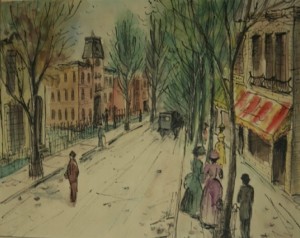by Erika Neenan
Paris by Paul White provides a window into Parisian life during the Victorian era. An old carriage travels down the road as men and women in Victorian dress populate the tree lined streets. A Second Empire building stands prominently on the left hand side of the painting. All of these elements declare that this scene is taking place in Paris during the Victorian age. The artist, however, could not have painted this scene from life. Paul White was born in 1917, well after the Victorian age had ended, and was a working artist in Mystic during the mid-late twentieth century. Why would an artist choose to focus on a time period in which he had never lived? White’s involvement with The Emporium provides essential insight as to why the Victorian era captivated his attention and featured so heavily into this work.

White was born in Ohio and settled in New York City after earning an MFA from the Chicago Art Institute. While in the city, White became associated with actor Leland Howard and the two decided that they should open a business together. They looked toward Connecticut as a location for their yet-to-be-determined business and in 1965 they purchased the building that is now known as The Emporium. The structure had been built in 1859 during the Victorian era. Victorian architecture is known for eclecticism in its sources, and the architect of this building had clearly drawn inspiration from Renaissance models, as noted in the use of pilasters and the overall symmetry of the building’s design. After re-furbishing the building, the men decided to turn it into a store that sold Victorian antiques and merchandise. White and Howard even wore Victorian garb as proprietors of the store. The Victorian age seeped into his everyday life and no doubt his operations of the store inspired the subject matter of Paris. Not only are the buildings and figures Victorian in this painting, but the woman in the yellow dress on the right hand side of the work is actively shopping, peering into the storefront window of a Victorian age shop—a shop that White was trying to invoke with The Emporium.

